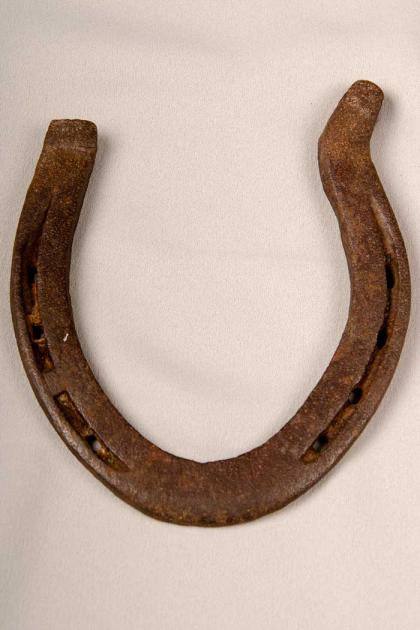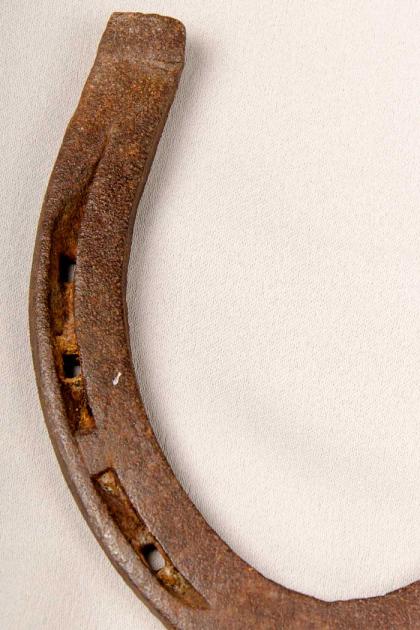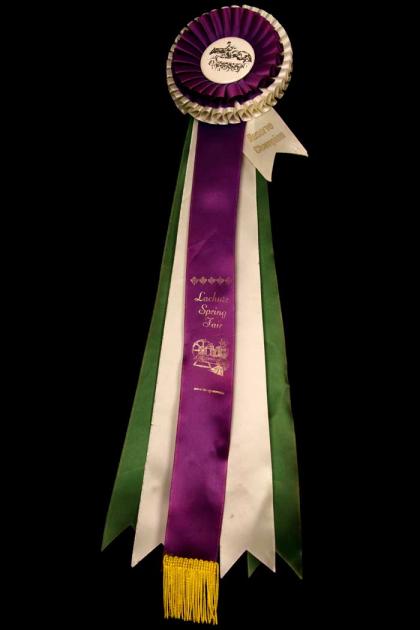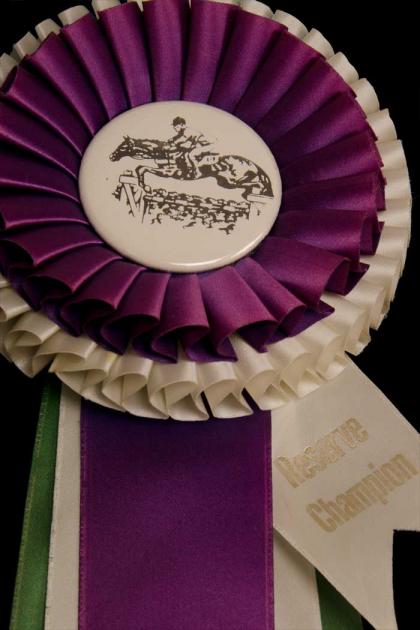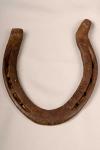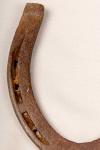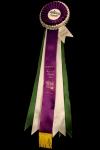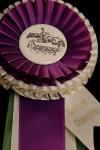Horseshoe
Organization:Musée régionale d'Argenteuil
Coordinates: www.museeregionaldargenteuil.ca
Address: 44, route du Long-Sault, Saint-André-d'Argenteuil, QC J0V 1X0
Region: Laurentians
Contact: Lyne St-Jacques, info(a)museearg.com and Scott Lees, President of Lachute Fair, info(a)expolachutefair.com
Description: Iron horseshoe that may have been worn by a workhorse in the ploughing competitions at the Lachute Fair
Year made: circa 1900
Made by: Likely made by a local blacksmith
Materials/Medium: Iron
Colours: Black
Provenance: Unknown
Size: 17.78 cm x 15.24 cm x .084 cm
Photos: Rachel Garber. Courtesy Musée régionale d'Argenteuil
The Oldest Agricultural Fair in Quebec
Brenda Hartwell
Lachute Fair has earned bragging rights as the oldest agricultural fair in Quebec and the second oldest fair in all of Canada. Since its founding in 1825, the Lachute Fair has promoted pride in husbandry, rewarded excellence and provided a fun-filled event for the entire family.
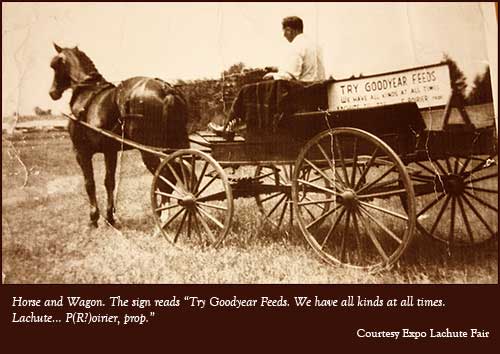
The story begins in the seigneurie of Argenteuil, in the days before Argenteuil was a county. During the years 1825 and 1826, meetings were held in the town of St. Andrews to form an association to sponsor the fair. Briefly known as “York Agricultural Society” and “Two Mountains Agricultural Society,” the name “Argenteuil Agricultural Society” was finally adopted in 1826, and under this name, it has sponsored the fair to the present day.
Unfortunately records from the earliest days have not been retained, so information concerning the first fairs is somewhat foggy. The souvenir programme celebrating the 150th anniversary of Lachute Fair (1825-1975), explains that the Fair was not always held in Lachute. “Cattle Shows and ploughing matches were held alternatively between Lachute (then called the Chute) and St. Andrews.” However, an article about the Argenteuil Agricultural Society states that during “its first fifty years, the fair rotated among the towns of Argenteuil, St. Andrews East, St. Philippe, and Carillon” (Stock).
Fortunately a four-page pamphlet from 1826, outlining the objectives and rules of the fair, has been preserved. It states: “The object of this Society is to promote, by its efforts and example, the science of Agriculture throughout the County; to give premiums in money or pieces of plate, agricultural publications or implements, to the practical farmers who shall excel in the art of ploughing, cropping, raising stock of all kinds, in the dairy, planting of fruit trees, and the general improvement of Farm and Home Manufactures”…“the rules of competition to be similar to those adopted by the Highland Society of Scotland” (Stock).
The Fair, powered by English-speaking volunteers, was initially held at harvest time. At the time of Confederation (1867), the fair was a bustling concern, with exhibits of wool ready to be spun, fancy work and linen, as well as many classes of wheat, rye, flax, barley, white beans and peas. Apples, pears, grapes, butter and cheese were displayed in abundance, and the barns were filled with carriage horses, mares with foals, stallions, fillies, cows, bulls, rams, ewes, boars, sows and lambs.
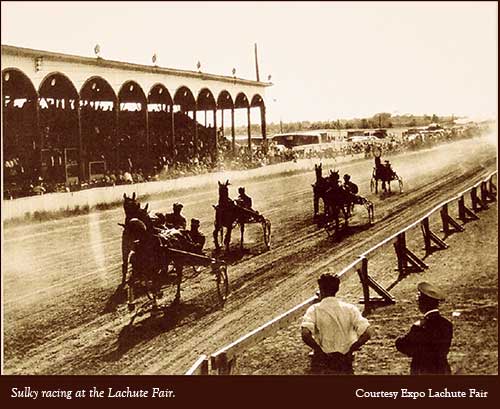
A permanent site for the fair was eventually established on the outskirts of Lachute, because it was served by the railroad and was considered a central point of the county. In 1877, Henry Hammond donated 15 acres for exposition grounds. The grandstand and racetrack were constructed in 1917, and new cow and horse barns were built as time and money allowed.
Lachute Fair was moved to springtime in 1925, and became known as the Lachute Spring Fair. The 150th anniversary souvenir programme (1975) billed the celebration as Exposition Lachute Spring Fair, and festivities included parades, R.C.M.P. Musical Ride, a horse show, a car derby, tractor and horse pulls, Calf Scramble, outdoor BBQ and full exhibits in the Arena, metal building and the animal barns.
Through the years, building repairs and new constructions have been funded, in large part, through donations, and much of the work has been accomplished by volunteers. A heavy horse barn was built in 1985, and in 1994 a generous donation from Storrs McCall allowed for the construction of a new dairy barn. A new arena was erected in 1995 and the grandstand was covered in 1997.
Expo Lachute Fair is much more than its physical site or buildings. An editorial that appeared in the Montreal Gazette in 1953 states: “The county fair is a Canadian institution which has played a prominent part in the progress of the nation, the maintenance of cherished traditions and the formation of the character of the people.” ... “It, for many generations, has promoted pride in a husbandry which long since has placed the maple leaf trademark of Canada at the top for many agricultural products in the markets of the world.” Good-natured rivalry among exhibitors helped to raise the bar with each passing year. Crops were improved, animals were bred for excellence and farm products were refined.
The Fair has evolved to reflect the changing landscape of farming technology. As agriculture became more mechanized, the Fair included events such as tractor pulls. Traditional skills and products are celebrated alongside newfangled innovations, and in this way, the exposition provides valuable links between past and present methods.
A tradition that began when most of Quebec society was rural dwelling, the Lachute Fair provided a rare and well-deserved holiday from the hard physical labour of the farm. The social event of the year, it brought the community together in a joyous celebration of agriculture, competition and expertise. Today, although many people have left the farms, the Fair draws an annual crowd of between 8,000 and 10,000 people. Attendees come from the surrounding communities, and many who have moved away schedule their vacations to coincide with fair time, and make an annual trek back home to reconnect with school chums and family.
Current Fair President Scott Lees has attended the exposition every year since his birth. It’s a family tradition. During his life, he has witnessed many young 4-H exhibitors grow up to become adult exhibitors and the volunteers who keep the fair functioning. He says funding from Ministère Agriculture, Pêcheries et Alimentation Québec helps keep the fair afloat.
This artefact, an iron horseshoe on display alongside Lachute Fair memorabilia in the Argenteuil Regional Museum, is an appropriate symbol for a solid event that began with a ploughing competition and has endured for nearly 200 years. Deceptively simple in appearance, it supported the great weight of a workhorse, just as the fair supported agricultural excellence, food security and community.
With mounting interest in terroir (local) products and the “100-mile diet,” modern-day Quebeckers are realizing that locally-sourced fresh food is nutritious, delicious and ecologically sound—facts that farming folk have promoted for generations.
Sources
Sandra Stock. Argenteuil Agricultural Society (1826- ). http://laurentian.quebecheritageweb.com/article/argenteuil-agricultural-...
Exposition Lachute Spring Fair Souvenir Programme, 1825-1975. 1975. Argenteuil Regional Museum Collection.
Expo Lachute Fair website, http://expolachutefair.com
Montreal Gazette. June 14, 1953, page 8. Minister to Open Lachute Fair. http://news.google.com/newspapers?nid=1946&dat=19550614&id=tDMjAAAAIBAJ&...
Telephone interview with Mr. Scott Lee, President of Expo Lachute Fair. February 2013.
Lachute, http://en.wikipedia.org/wiki/Lachute
To Learn More
Canadian Association of Fairs and Exhibitions, www.canadian-fairs.ca
The Association des Expositions du Québec, www.expoduquebec.com
Author
Brenda Hartwell is a writer and editor. She lives in Quebec's Eastern Townships.


